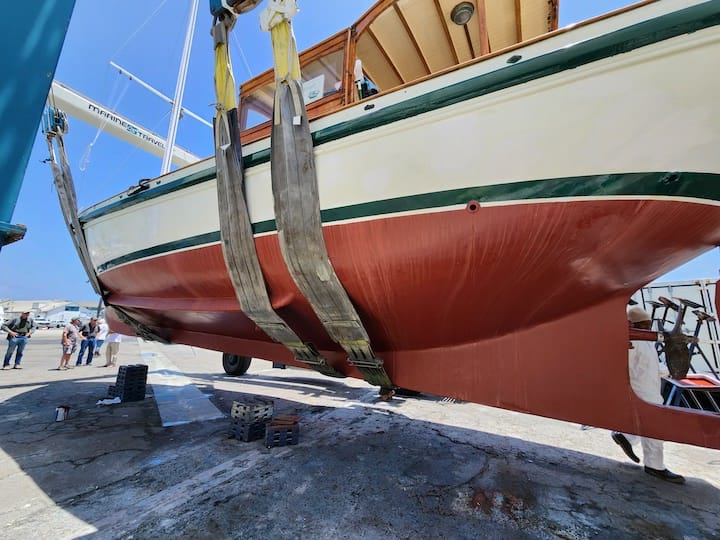Curator’s Log – Summer 2023 Ranger Restoration

By Lydia Rao
You might have noticed this spring that SBMM’s flagship Ranger was missing from her usual spot, side-tied in front of the museum. This was the result of a continued effort to complete some much-needed repairs beyond the scope of the regular Ranger crew, who meet twice a week to keep everything ship-shape. These issues had been identified by marine surveyor Mike Pyzel back in March of 2022, and while the Ranger exhibit case underwent an update in August of the same year, it was clear the real deal needed some attention as well. By January 2023, the divers performing routine hull cleanings reported that parts of Ranger’s hull were showing stress and needed to be addressed.
And so, on May 11, Ranger was hauled out and taken to dry dock in the Harbor Marineworks yard, where seven weeks of cleaning, conservation, and restoration took place. The three main goals were to repair damage to the port side rub rail, assess the integrity of the mast, and replace the rigging. Harbor Marineworks helped perform routine maintenance such as pressure washing the hull, along with sanding and applying a new coat of antifouling paint.
All of the rigging had to be removed for the mast to come down, this was handled by the Ranger crew and Ocean Aire Marine Electronics. Both the standing and running rigging were more than 20 years old and in poor shape; with cracked and rusted cable end fittings, and bent turnbuckles with damaged threads. For obvious safety reasons, rigging is recommended to be replaced every 15 years.
After this, the mast was unstepped using the crane at Harbor Marineworks. Once removed, it was clear the mast had rot in several places, caused by water ingress from the mast electronics and spreader bars. These damaged sections were removed and filled with wood and epoxy, then planed and sanded flush to prepare the mast for painting. To reduce further water damage, several changes were made to the mast, including routing a new channel for the electronic cables to emerge below the deck instead of above, creating a more watertight design. The dilapidated wooden spreaders were also rebuilt from scratch, with new custom brackets welded to maintain the integrity of the wooden mast and the spreaders.
The foot of the mast (where it meets the deck) was also meticulously repaired and fortified with epoxy. Special attention was paid to reinforce this section as the foot carries the entire weight of the mast, rigging, and sails. A new mast boot was built to create a better seal where the mast meets the deck. The team at Harbor Marineworks primed and painted the mast and used the crane to re-step it. Ocean Aire helped outfit Ranger with a whole new set of rigging that meets all current standards, along with new electronics such as VHF radio antenna, steaming light, all around anchor light, and new wiring.
The Ranger crew focused on cutting out rotted portions of the rub rail and fitting new wood patches into the holes before sealing and painting. The anchor guards and hawse pipes were cleaned up, and small dings were repaired; all work that simply couldn’t be completed with the boat in the water because of the proximity to the waterline. The forestay was reinforced and painted, a vital support point for the mast rigging. A professional sign painter also gave the name on the stern a touchup and added Ranger to both sides of the bow for easier recognition.
On June 29, 2023 Ranger finally returned to the water, with a short and easy return to her slip. Crew members continued to work on interior restoration, as well as reinstalling the boom and mainsail, new anchors, and ladder rungs (or rat-boards) on the rigging. On July 15, 2023 Ranger went on her first cruise in several years, and performed beautifully. It was a sunny day with minimal swell and wind. However, as any boat owner knows, the work is never finished, and doubly so for a boat built in 1917.
In the seven weeks Ranger was out of the water, museum volunteers put in more than 300 hours of work. The volunteer crew consisted of Tom Elliott, Mark Wardman, John Hill, Glen Varcoe, Don McVay and Becky Winchester, with captains Jim Spellman and Tony Paterson. And of course, all of this work could not have been done without the generous donors who pledged the funds to make it happen including the June G. Outhwaite Charitable Trust, Andy Cooper, Tom Elliott, and Mark Wardman.
